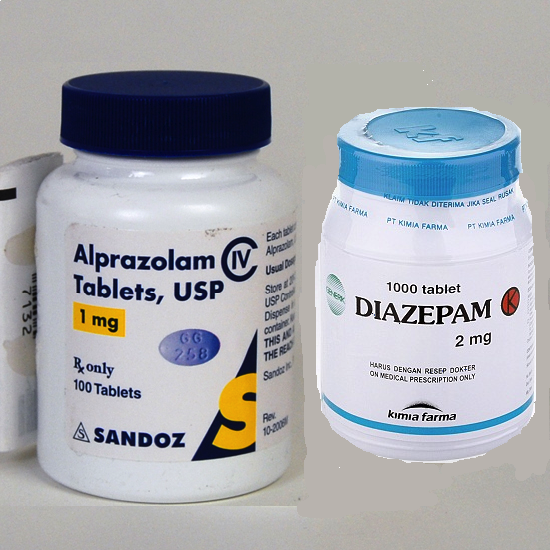Clonazepam is used less frequently than alprazolam, as it takes a little longer to be effective, but it is also longer lasting. There are two recommended dosage levels for clonazepam: one for seizure control, and one for anxiety. It is important to be aware of this, as the dosage for seizure control is much higher than that used for anxiety. I was reassured to me to realize how high a dose could be given without being dangerous.
Alprazolam, like its more famous cousin Diazepam (Valium®), is a benzodiazepine tranquilizer. It works by depressing activity in a number of areas of the brain, which leads to several desired effects. It works as an anti-anxiety treatment, as a sedative, as a suppressor of seizure activity, and as a muscle relaxer. The exact mechanism for creating these effects is unknown. Alprazolam represents an improvement on the original diazepam in that it lasts longer in dogs, making it more practical than diazepam for oral use.
Diazepam is more sedating than the other drugs in this class, and may have less anxiolytic effect, so it is generally not recommended for anxiety. It is the shortest-acting of this drug class in dogs, and does not take effect as quickly as the others.
In Piglet’s case, benzodiazepines were a lifesaver.I found an article by Dr. Overall that discussed the use of alprazolam for noise phobias (see “References” below). I started Piglet at 0.25 mg (0.017 mg/kg), but that had little effect, so I went to 0.50 mg (0.03 mg/kg), which did help. I started by giving Piglet this dosage of alprazolam whenever she would wake me up, which was generally a couple of hours after we went to sleep. She would usually settle down within an hour after getting the medication. It was helping, but it wasn’t enough.
My vet then suggested that I give an increased dosage of alprazolam at bedtime, before Piglet became anxious. Rather than giving her 0.5 mg (barely enough to help), after she had awakened me with her anxious behavior, I began giving her 1 mg (0.07 mg/kg) at bedtime. This made a huge difference. The alprazolam did not sedate Piglet; it just relaxed her enough to be able to sleep, without anxiety waking her up during the night. By giving it to her before she became anxious, she was able to sleep through most of the night.
After consulting with a veterinary behaviorist, I started giving Piglet 1 mg alprazolam every eight hours, to try to prevent her from becoming anxious. Her anxiety was under control, but she seemed to be on something of a roller coaster, becoming more reactive each hour after the alprazolam was given. I generally had to get up once during the night to give her a dose, as it was too short-acting for her to be able to make it all the way thru the night without waking and becoming anxious.
I decided to switch to clonazepam, as its effects last longer. Because the recommended dosage range of clonazepam for anxiety in dogs is similar to that for alprazolam, I tried giving Piglet the same dosage (1 mg), but quickly found out that was not enough. I increased the dosage to 2 mg (0.13 mg/kg), still well within the recommended range. I gave this amount twice a day, at bedtime and after breakfast. With clonazepam, Piglet was able to sleep through the whole night.


